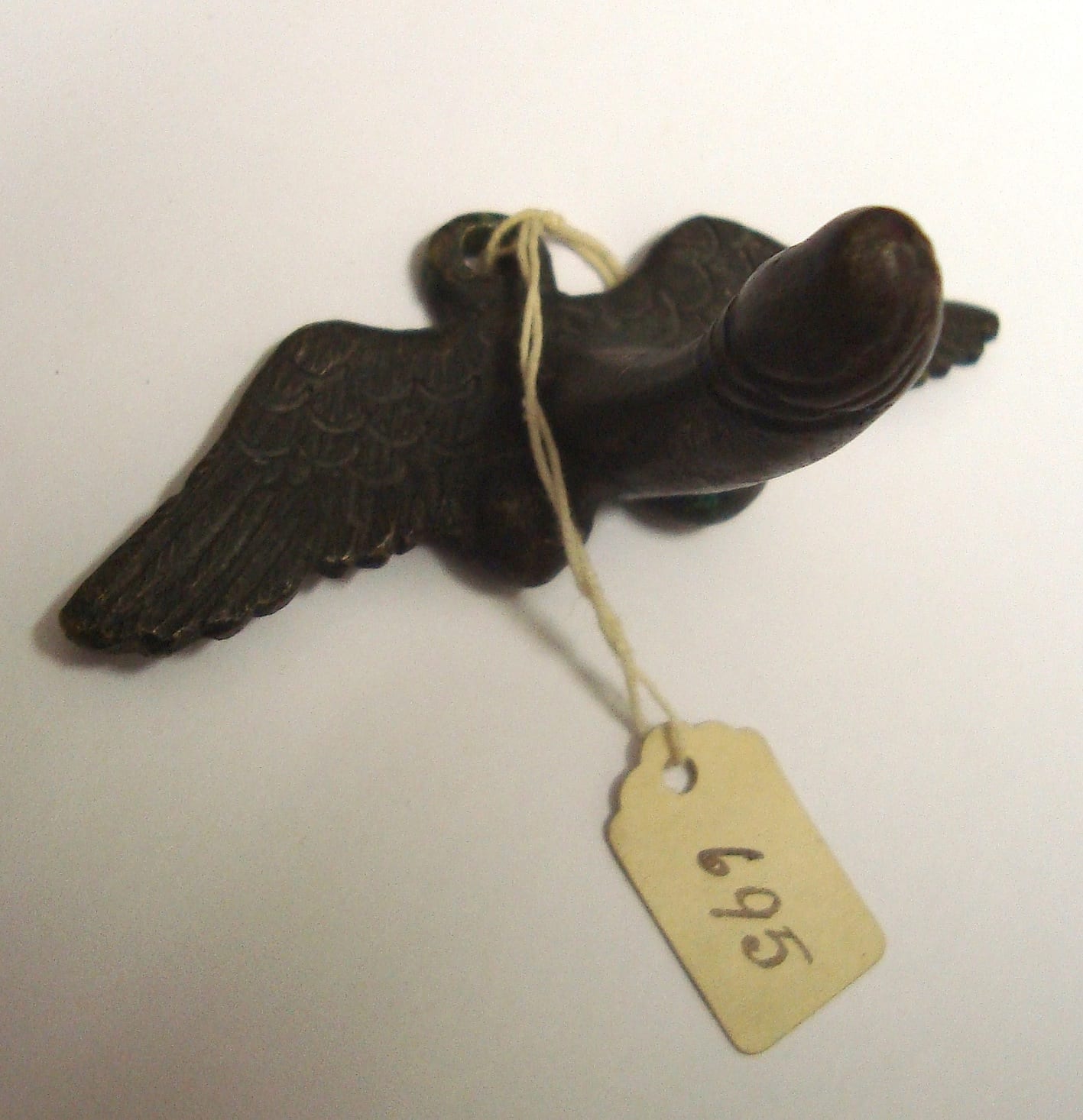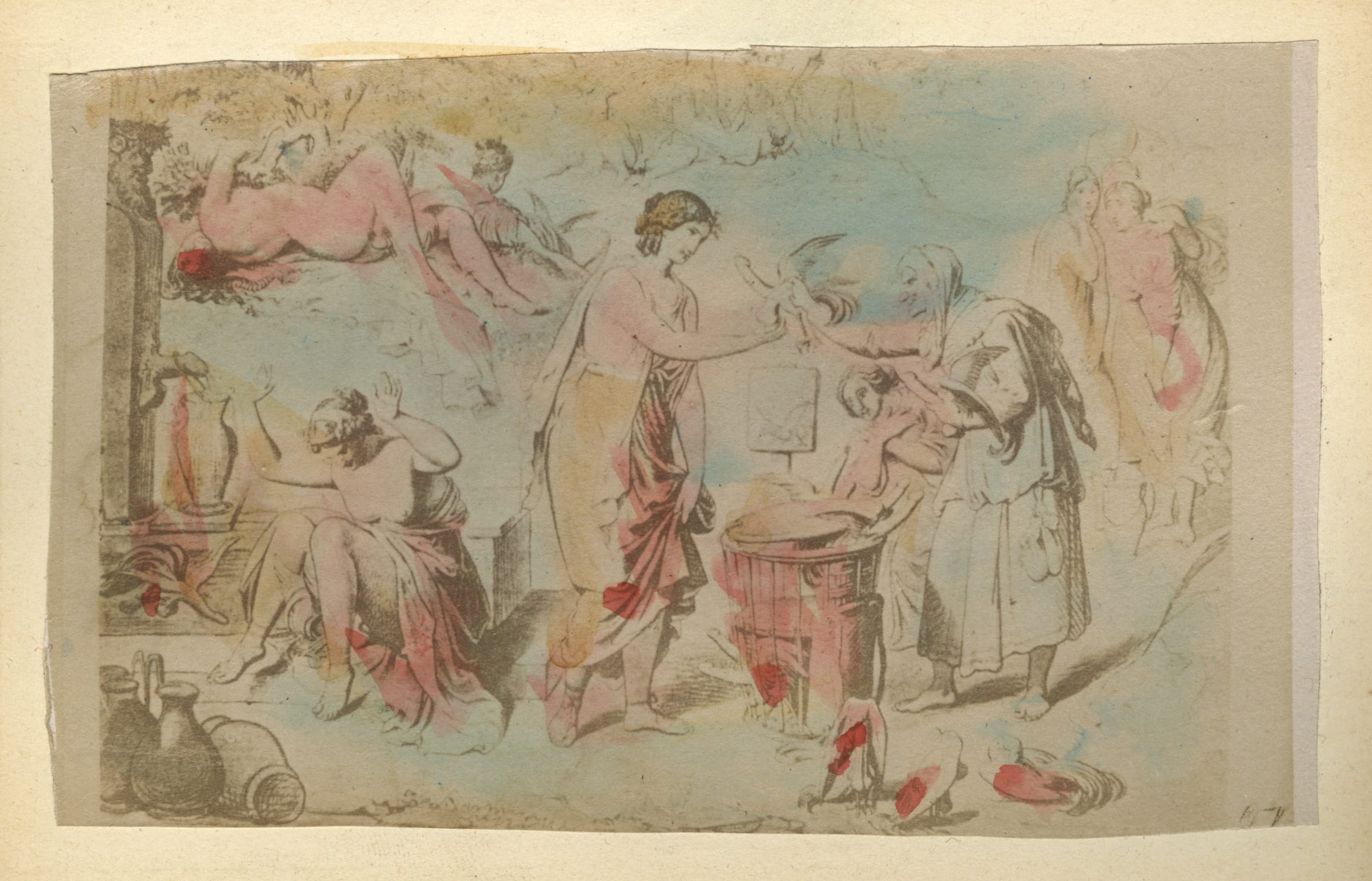Fascinus & the Winged Phallus Tattoo
By Gemma Angel, on 7 January 2013
 by Gemma Angel
by Gemma Angel
During a recent visit to the UCL Archaeology collections, I came across a very interesting object: a small bronze pendant in the form of an erect penis with a pair of wings, outstretched as though in flight (pictured below right). I was intrigued by this unusual item of Roman jewellery, partly because I was struck by the absurdity of a disembodied flying penis – but partly because the iconography of this motif was familiar to me.

Winged phallus pendant in bronze, measuring
6.5cm in length. From the Gayer-Anderson
classical collection (Graeco-Roman),
UCL Institute of Archaeology.
I had previously seen graphic representations of this design in the course of my own research, as tattoos on human skin. My doctoral work focuses upon the collection and preservation of tattooed human skins during the 19th and 20th centuries. The core collection that I work with at the Science Museum dates from the latter part of the 19th century in France, and much of the iconography of these tattoos is of European origin. During a research trip to Paris in 2010, I had the opportunity to see a similar collection of dry-preserved tattoos stored at the anthropology department of the Muséum national d’Histoire naturelle (MNHN). Amongst the 54 tattoos in their collection, there was one skin fragment tattooed with a winged phallus (pictured below). Although the tattoo is very faded, the characteristic outstretched wings and erect penis are clearly discernible; in this case red ink has been used to emphasize the virility of the phallus. Whilst tattoo motifs such as this one may seem amusing, puerile or even obscene to us today, this particular image actually has a long iconographic history embedded in religious practice and ritual, going at least as far back as Ancient Rome.
Phallic charms were commonplace in Roman culture, both in the form of jewellery and other decorative household items, such as lamps and wind chimes. In ancient Roman religion and magic, representations of the winged phallus are usually referred to as fascinum, and symbolise the divine phallus or the embodiment of the Roman deity of fertility, Fascinus. The words can be used to refer to both phallus effigies and amulets, and spells used to invoke his divine protection. Fascinum are frequently associated with Liber Pater, an ancient Roman god of fertility and cultivation, often identified with Bacchus and his Greek counterpart, Dionysus. In rural areas of Italy, the festival of Liberalia celebrated the coming of age of young boys on the 17th of March, and traditionally involved processions, sacrificial offerings and song. Processions featured a large phallus which was carried through the countryside by devotees, in order to protect crops from evil and bring fertility blessings to the land and the people. At the end of the procession a wreath was placed on the phallus by a respected older female member of the community.
St. Augustine (354AD-430AD) a bishop of Hippo Regis (present-day Algeria), recounts these pagan celebrations from Varro [1], describing the ancient fertility processions with a strongly disapproving Christian bias:
Varro says that certain rites of Liber were celebrated in Italy which were of such unrestrained wickedness that the shameful parts of the male were worshipped at crossroads in his honour. […] For, during the days of the festival of Liber, this obscene member, placed on a little trolley, was first exhibited with great honour at the crossroads in the countryside, and then conveyed into the city itself. […] In this way, it seems, the god Liber was to be propitiated, in order to secure the growth of seeds and to repel enchantment (fascinatio) from the fields. [2]
Although considered obscene by the Christian clergy, fascinum were used to ward off evil, and were worn as protection charms, particularly by male children and soldiers.

Winged phallus tattoo on preserved human skin, dated 1904-5. From the collection of
the Muséum national d’Histoire naturelle (MNHN), Paris. Image © MNHN, Paris.
But what is the significance of the fascinum in the modern era? The rather extraordinary image below is one of a series of late 19th century tourist cards entitled “Postcards from Pompeii”, and features a number of winged phalli. As a 19th century representation of classical sexuality, which is contemporary with the preserved tattoo fragment pictured above, this image is of particular interest. The postcard depicts an old woman with a basket of winged phalli, which she offers to a young woman in the centre of the sketch. Two ‘living’ phalli can be seen straining eagerly out of the basket towards the young woman, whilst 3 others, apparently spent, sit limply in the foreground. The old woman holds a phallus in each hand, and a sign advertising her wares is visible behind the basket. Around this central scene, a number of other young women are engaged in orgiastic sexual activity with the winged phalli, whilst 3 others carrying empty urns look on, as though scandalized (background right). Although the young women depicted in the scene are drawn in classical style, the old woman has the typical appearance of a crone, more consistent with medieval pictorial conventions, suggesting an association with European concepts of witchcraft (for more on witchcraft and the winged phallus, see my previous post on lifeand6months).
The only recognisably male figure in the drawing appears on the far left, as a bust in profile atop a pillar; lower down the pillar a fount in the form of a phallus pours forth life-giving fluid into an urn. The wreath of fruits and grain crowning his head suggest that this figure is Liber Pater or Bacchus. Whilst there is a certain pornographic quality to this image, it also sheds light on European interpretations of the winged phallus: On the one hand it is associated with classical religion as a symbol of fertility, abundance and orgiastic excess, which celebrated masculine generative power; and on the other with late medieval conceptions of witchcraft, emasculating female sexuality and magical ‘penis theft’.

Women with flying phalli, illustration from Pompeii tourist album, c. 1880. Image courtesy of The Kinsey Institute for Research in Sex, Gender, and Reproduction. Click to enlarge.
It is difficult to know for certain how the tattooed 19th century European man regarded the winged phallus – it may be that it was worn by soldiers as a talisman against harm, according to contemporary interpretations of ancient practices. Or it may simply be that the image of a virile, flying penis was associated with sexual prowess, and appealed to a bawdy sense of humour. It is clear, however, that the motif retained its popularity long into the 20th century. Writing on the Chicago and Oakland tattoo scene during the 1950s and 60s, tattooist Samuel Steward mentions this tattoo in his quite disparaging discussion of superstitions and folklore in modern tattooing, including the belief that, ‘the winged phallus tattoo will assure the wearer great sexual powers’. [3] Though the magical or religious symbolism of the winged phallus may no longer have significance in contemporary European culture, the image still has its appeal. Perhaps considered more comic, playful or absurd in our present context, it still appears as a popular tattoo design, as the colourful example below demonstrates.

Contemporary example of the winged phallus tattoo, by tattooist Rachael Davies of
Five Star Tattoo, Louisville Kentucky, USA. Photograph courtesy of Rachael Davies.
References:
[1] Marcus Terentius Varro (116 BC – 27 BC) was an ancient Roman scholar and writer.
[2] English translation by R.W. Dyson: Augustine: The City of God against the Pagans (Cambridge University Press, 1998, 2002), p. 292. Available online.
[3] Samuel Steward: Bad Boys and Tough Tattoos: A Social History of the Tattoo With Gangs, Sailors and Street-Corner Punks (1950-1965), (1990) p.82.
[analytics-counter]
 Close
Close

